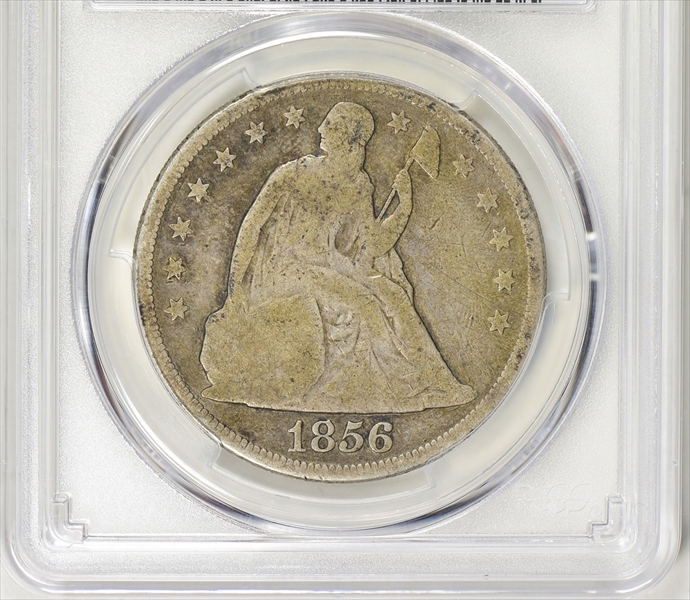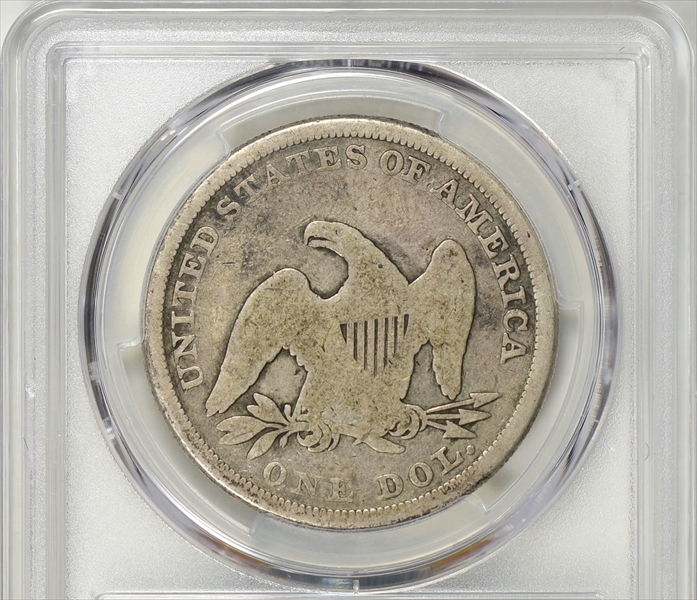1856 $1 G6 认证号84081132, PCGS号6944
专家评论
Q. David Bowers
The following narrative, with minor editing, is from my "Silver Dollars & Trade Dollars of the United States: A Complete Encyclopedia" (Wolfeboro, NH: Bowers and Merena Galleries, Inc., 1993).Coinage Context
Still another "trade dollar": Most 1856 Liberty Seated dollars were exported, many via the clipper ship trade to selected Chinese ports, where they were melted. During the era, millions of dollars' worth of tea and silk were imported from China into the United States. Other dollars were sent to Europe (see following). Still others may have gone to South America.
By 1856 the San Francisco Mint had been in operation for over two years, but despite requests to do so, it had not yet struck any silver dollars. The Philadelphia Mint had sent no dies of this denomination, nor would it until 1859.
Silver to China and India: The Bankers' Magazine and Statistical Register reported the following: (October 1856, p. 303.) "WHERE DID THE GOLD AND SILVER GO? It is well known that the silver coin held by the banks in the United States, eight or 10 years ago, has almost entirely disappeared to this day. The remnants are composed of small coin, reserved for change. Gradually, from the years 1848 to 1855, all of the available silver coin of this country was exported to Europe; but there it did not remain. The exhaustion of silver noted in the banking and commercial history of the United States, for the past eight years, has also taken place in Europe ....
"The government of the United States has adopted measures, rather late, it is true, but for the present effectual, for the prevention of further large exports of silver, by offering a liberal premium for silver coin, thus converting it into new coinage, with such alloy that its legal tender value at present is fully 10% over its market value as a commodity. [The reference here is to the Act of February 1853.] When we inquire further as to the causes and means of exhaustion of silver in Europe, we find that the preference felt for the metal in China and India demands a continued export of all that can be realized .... "
The same publication, issue of September 1856, pp. 200-201, noted that in England much silver had been exported directly to China and the East Indies amounting to £1,716,100 in 1851, £2,630,238 in 1852, £4,710,665 in 1853, £3,132,003 in 1854, and £6,409,889 in 1855. "The main cause we opine lies in the enormous increase of Chinese exports of silk and tea to England and North America." Presumably, large amounts of American silver coins were sent from the United States to China during the same time for essentially the same purposes.
A. Barton Hepburn's History of Currency in the United States, 1915, included a column for exports of domestic U.S. coins in millions of dollars per year. The figures are enlightening: 1850 $2.0, 1851 $18.1, 1852 $37.4, 1853 $23.5, 1854 $38.1, 1855 $54.0, 1856 $44.1, 1857 $60.1, 1858 $42.4, 1859 $57.5, and 1860 $56.9. Most of these coins had to be gold, as silver coinage did not rise above $9.1 million in any year except 1853, and averaged something under $5 million per year. The net result was, for all the out-pouring of coin in the 1850s, the total amount of specie in the country barely increased after 1853, and actually declined from 1857 to 1860. (Harry E. Salyards, M.D., called my attention to the Hepburn citation and furnished comments concerning it.)
Numismatic Information
Circulated grades: Although 1856 has more than double the circulation strike mintage of 1855, in circulated grades the rarity of the two dates is about the same. If anything, the 1856 seems to be slightly the rarer of the two. In 1859 in his American Numismatical Manual, Dr. Montroville W. Dickeson called the 1856 silver dollar rare, and this was just three years after it was issued!
In his 1984 study published in The Gobrecht Journal, "Availability of Liberty Seated Dollars by Grade," John Kroon noted that he found 22 specimens (in all grades) of 1855 and just 18 of 1856. Contrasting this, the 45th edition of A Guide Book of U.S. Coins prices the 1855 at $1,375 in VF-20 grade and the 1856 at only $400. Such inequalities usually straighten themselves out in the numismatic market. Today, the 1856 seems to be bargain priced!
The date 1856, with slanting 5, is large (almost oversize) and bold on all silver dollars of this year.
Mint State grades: Although the 1856 dollar is an extreme rarity in Mint State, the appreciation of it by advanced collectors, and, to an extent, its market price, have been dimmed slightly by the availability of Proofs of this date. Proofs, although rarities in their own right, have served to absorb some of the demand for top-grade coins. Mint State 1856 dollars are few and far between. Like the 1855, here is a fantastic sleeper.
Varieties
Circulation strikes:
1-4. Normal Date: Breen-5453. Five die pairs were prepared for circulation strikes, but it is not known if all were used. All known examples have large date with slanting or italic 5. Some early impressions have "chin whiskers" to Miss Liberty, or file marks in the die below the chin.
5. 1856/4 Overdate: Breen-5454. Walter H. Breen reports an overdate, "1856/4," noting that it is extremely rare and that New Netherlands Coin Company's Sale 47, Lots 1147-48, offered two of these, distinguished by having a plain straight line, the crossbar of the underdate 4, within the 6. Unpublicized.
Dies prepared: Obverse: Unknown; Reverse: Unknown
Circulation strike mintage: 63,500; Delivery figures by day: January 30: 10,000; January 31: 18,000; February 4: 17,000; February 9: 18,500.
Estimated quantity melted: Unknown
Characteristics of striking: Usually weakly struck, typically with Miss Liberty's head and stars 8 through 10 flat. On the reverse, the eagle's dexter leg is often weak.
Known hoards of Mint State coins: None
Commentary
Most 1856 circulation strike dollars were exported.
Examples are rare today in all grades.
Additional Information
General Silver Coinage
The Annual Report of the Director of the Mint, 1856, advised that since the passage of the Act of March 3, 1853, authorizing a reduction in the weight of silver coins, silver coins were circulating effectively. The director of the Mint felt, however, that the nation would never "fully realize the benefit of a sound specie circulation until all bank notes, at least below the denomination of $20, shall be excluded from circulation." However, this statement did not apply to silver dollars, which did not circulate in the United States.
Most private bank notes stopped circulating before the end of the Civil War, thanks to new laws. Evidently, after 1861 the Treasury wanted a monopoly, partly because many banks failed and left their creditors with worthless paper money, and partly to help finance the Civil War. Nevertheless, the United States did not enjoy a sound specie circulation until mid-December 1878, when for the first time in American history, federal silver coins, gold coins, and paper money were all on a par with each other.
PCGS #
6944
设计师
Christian Gobrecht
边缘
Reeded
直径
38.10 毫米
重量
26.73 克
铸币数量
63500
金属成分
90% Silver, 10% Copper
更高评级数量
148
评级较低的钱币数量
1
地区
The United States of America
价格指南
PCGS 数量报告
拍卖 - PCGS 评级的
拍卖 - NGC 评级的
稀有性和存量估计 了解更多
| 所有评级 | 1100 |
| 60或以上 | 50 |
| 65或以上 | 0 |
| 所有评级 | R-4.9 |
| 60或以上 | R-8.5 |
| 65或以上 | R-10.1 |
| 所有评级 | 5 / 30 TIE |
| 60或以上 | 11 / 30 TIE |
| 65或以上 | 1 / 30 |
| 所有评级 | 12 / 45 TIE |
| 60或以上 | 17 / 45 TIE |
| 65或以上 | 1 / 45 |

























